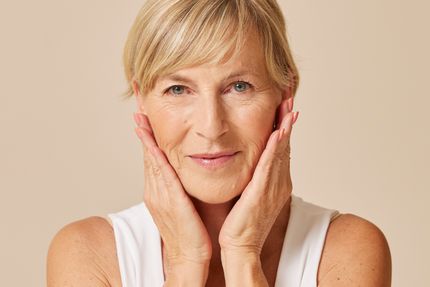

Love your heart: reduce your risk of cardiovascular diseases during menopause
Moving through life's phases, especially the menopausal transition, comes with challenges and changes. Some positive, some negative. The increased risk of developing heart and vascular diseases is a particular challenge that is often underestimated.
What are the risk factors? And what can you do to protect your heart when you’re transitioning to menopause?
Cardiovascular diseases in women
Women in general have a lower risk of being affected by cardiovascular diseases than men. That is, before menopause. During your body's transition to menopause, your risk increases.
This has everything to do with hormones. In particular, oestrogen. Oestrogen acts like a shield for your heart and arteries, keeping them supple and healthy. When perimenopause sets in and oestrogen levels start to fall, your blood vessels become less flexible. This can increase the risk of health problems.
Cardiovascular disease risk factors
Menopause introduces new risk factors for cardiovascular disease. Main risk factors include:
- High cholesterol: Levels of LDL cholesterol (or ‘bad’ cholesterol) can rise. This makes you more likely to get atherosclerosis.
- High blood pressure: Your blood pressure can rise, which increases your risk for cardiovascular diseases.
- Weight gain: Many women in their forties and fifties experience weight gain, especially around the midsection. Too much fat in this area can increase your risk of cardiovascular disease.
Do you need more support?
How can you protect your heart?
So, now that we've covered the risks, what can you do to protect your heart health? There are a lot of things you can do, perhaps more than you realise.
1. Healthy diet
What you eat plays a huge role in every aspect of your health, including your hormonal balance. This may sound like a cliche, but cliches are cliches for a reason. Here are some basic health tips to keep in mind.
- Eat lots of fruit and vegetables (at least 500 grams a day) and opt for foods that are rich in protein, healthy fats and slow-acting carbohydrates.
- Omega-3 fatty acids in sources such as fatty fish and nuts are great for your heart. They help reduce low-grade inflammation in the body and balance cholesterol levels.
- Avoid trans fats. Trans fats are mostly found in hydrogenated vegetable oils such as margarines. It’s best to avoid products with this type of oil (e.g., crackers, cookies, cakes, pastries).
- Steer clear of products with added sugars and fast carbohydrates. The body stores any excess energy as fat, which is an important risk factor (see above).
- Fructose is a form of sugar that is found is many sweet products. A high intake of fructose can lead to a buildup of fat in the liver. A diet that is high in cholesterol can also create fat around the liver.
2. Regular exercise
Regular exercise is one of the best ways to keep your heart strong. It helps lower your blood pressure, control your weight and improve your cholesterol levels.
Alternate strength training with cardio activities, such as walking, swimming or yoga. Generally, exercising for at least 30 minutes a day is recommended.
3. Reduce stress
For many, menopause can feel stressful in itself. Throw in a busy lifestyle on top of that and your body can get stuck in cortisol production overdrive. Having high levels of the stress hormone cortisol has a direct effect on the cardiovascular system.
Therefore, you should try to avoid stress as much as possible. Or learn to deal with stress in healthy ways. For instance, by doing relaxing activities (e.g., yoga, breathing exercises, reading or walking) and by taking regular breaks.
A good break is not scrolling through social media feeds on your phone, texting or sending e-mails. The best way to spend a break is to have a chat with a colleague, go for a walk, listen to music, or simply sit and stare out the window.
Make a conscious effort to take breaks. Taking breaks is often the first thing we skip whenever we're busy, but it is essential for keeping your heart and blood vessels healthy.
4. Smoking and alcohol
Do you smoke? Find ways to quit smoking. Nicotine addiction is a very powerful craving, so it’s not going to be easy. Luckily, there is help out there, so you don’t have to do it alone. Drinking alcohol is also a big risk factor for cardiovascular disease. Finding it difficult to quit because you love wine so much? Try only drinking on weekends or at birthdays and parties instead of abstaining from alcohol altogether.
5. Monitor your health
At this stage of your life, it's a good idea to have your blood pressure, cholesterol and blood sugar measured annually. This way, risk factors are detected, and you can get treated in a timely manner.
Love your heart
Your heart deserves care and attention, especially in the years surrounding menopause. Despite all the hormonal changes that are occurring in your body, it is possible to keep your heart healthy. A healthy diet, regular exercise and managing stress are all things you can do to lower your risk of heart problems. Your heart is the beating muscle that keeps you well and alive. Doesn’t it deserve the best attention it can get?
Is hormone therapy an option?
Hormone therapy supplements the body with hormones that are lost during menopause and can help reduce the risk of developing osteoporosis and cardiovascular disease. It's best to start hormone therapy as soon as your symptoms begin. Could hormone therapy be an option for you?

Sources
- Wild RA, Hovey KM, Andrews C, Robinson JG, Kaunitz AM, Manson JE, Crandall CJ, Paragallo R, Shufelt C, Merz CNB. (2021). Cardiovascular disease (CVD) risk scores, age, or years since menopause to predict cardiovascular disease in the Women's Health Initiative. PMID: 33950030.
- Lejsková M, Alušík S, Valenta Z, Adámková S, Piťha J. (2012). Natural postmenopause is associated with an increase in combined cardiovascular risk factors. PMID: 23098660.
- Colpani V, Baena CP, Jaspers L, van Dijk GM, Farajzadegan Z, Dhana K, Tielemans MJ, Voortman T, Freak-Poli R, Veloso GGV, Chowdhury R, Kavousi M, Muka T, Franco OH. (2018). Lifestyle factors, cardiovascular disease and all-cause mortality in middle-aged and elderly women: a systematic review and meta-analysis. PMID: 29524110.
- Sánchez-Delgado JC, Jácome-Hortúa AM, Yoshida de Melo K, Aguilar BA, Vieira Philbois S, Dutra de Souza HC. (2023). Physical Exercise Effects on Cardiovascular Autonomic Modulation in Postmenopausal Women-A Systematic Review and Meta-Analysis. PMID: 36767574.
- Zhang J, Chen G, Lu W, Yan X, Zhu S, Dai Y, Xi S, Yao C, Bai W. (2014). Effects of physical exercise on health-related quality of life and blood lipids in perimenopausal women: a randomized placebo-controlled trial. PMID: 24937024.
Possibly of interest to you


FAQ
How can I keep my cholesterol levels and blood pressure in check during the menopause?
One of the best ways to take care of your body and mind to control your cholesterol and blood pressure is to exercise. Try to exercise for at least 30 minutes a day. Alternate strength training with activities such as running or swimming. Stress, and therefore cortisol, also has a negative effect on blood pressure. Therefore, plan enough moments of relaxation. And as always: eat a healthy and varied diet. More about lifestyle and nutrition.










